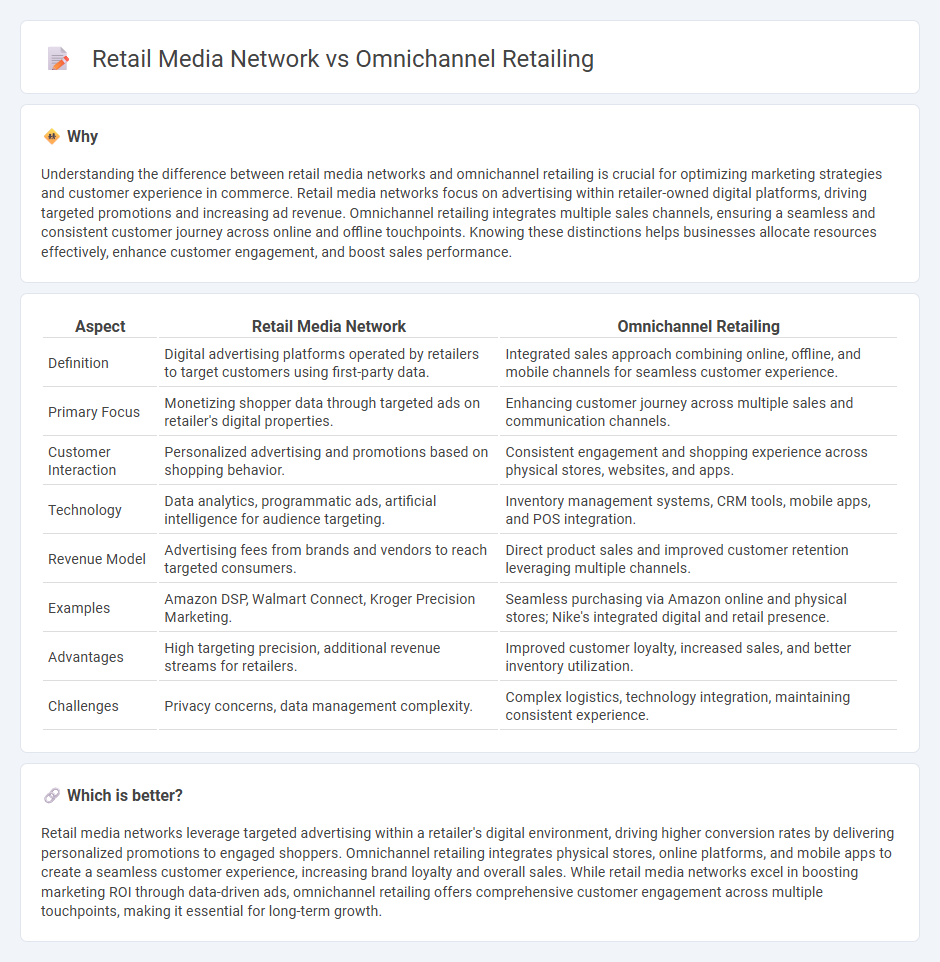
Retail media networks leverage digital advertising platforms integrated within retail sites to target consumers with personalized promotions, driving higher engagement and sales. Omnichannel retailing combines physical stores, online platforms, and mobile apps to create a seamless shopping experience across all customer touchpoints, enhancing convenience and loyalty. Discover the key differences and strategic benefits of retail media networks versus omnichannel retailing for modern commerce.
Why it is important
Understanding the difference between retail media networks and omnichannel retailing is crucial for optimizing marketing strategies and customer experience in commerce. Retail media networks focus on advertising within retailer-owned digital platforms, driving targeted promotions and increasing ad revenue. Omnichannel retailing integrates multiple sales channels, ensuring a seamless and consistent customer journey across online and offline touchpoints. Knowing these distinctions helps businesses allocate resources effectively, enhance customer engagement, and boost sales performance.
Comparison Table
| Aspect | Retail Media Network | Omnichannel Retailing |
|---|---|---|
| Definition | Digital advertising platforms operated by retailers to target customers using first-party data. | Integrated sales approach combining online, offline, and mobile channels for seamless customer experience. |
| Primary Focus | Monetizing shopper data through targeted ads on retailer's digital properties. | Enhancing customer journey across multiple sales and communication channels. |
| Customer Interaction | Personalized advertising and promotions based on shopping behavior. | Consistent engagement and shopping experience across physical stores, websites, and apps. |
| Technology | Data analytics, programmatic ads, artificial intelligence for audience targeting. | Inventory management systems, CRM tools, mobile apps, and POS integration. |
| Revenue Model | Advertising fees from brands and vendors to reach targeted consumers. | Direct product sales and improved customer retention leveraging multiple channels. |
| Examples | Amazon DSP, Walmart Connect, Kroger Precision Marketing. | Seamless purchasing via Amazon online and physical stores; Nike's integrated digital and retail presence. |
| Advantages | High targeting precision, additional revenue streams for retailers. | Improved customer loyalty, increased sales, and better inventory utilization. |
| Challenges | Privacy concerns, data management complexity. | Complex logistics, technology integration, maintaining consistent experience. |
Which is better?
Retail media networks leverage targeted advertising within a retailer's digital environment, driving higher conversion rates by delivering personalized promotions to engaged shoppers. Omnichannel retailing integrates physical stores, online platforms, and mobile apps to create a seamless customer experience, increasing brand loyalty and overall sales. While retail media networks excel in boosting marketing ROI through data-driven ads, omnichannel retailing offers comprehensive customer engagement across multiple touchpoints, making it essential for long-term growth.
Connection
Retail media networks leverage consumer data from omnichannel retailing to deliver personalized advertising across multiple platforms, enhancing customer engagement and boosting sales. Omnichannel retailing integrates physical and digital shopping experiences, providing comprehensive customer insights that feed targeted campaigns on retail media networks. This synergy drives more effective marketing strategies by aligning advertising efforts with seamless, data-driven customer journeys.
Key Terms
Customer Experience
Omnichannel retailing integrates multiple shopping channels like physical stores, online platforms, and mobile apps to create a seamless and personalized customer experience, emphasizing convenience and consistency across touchpoints. Retail media networks leverage advertising opportunities across a retailer's owned digital properties to deliver targeted promotions that enhance customer engagement and drive sales. Discover how these strategies uniquely impact customer experience and business growth.
Cross-Channel Integration
Omnichannel retailing emphasizes seamless cross-channel integration by unifying physical stores, online platforms, and mobile apps to create a consistent customer experience. Retail Media Networks focus on leveraging retailer-owned digital advertising platforms to target consumers across multiple channels, enhancing personalized marketing efforts. Explore how both strategies optimize customer engagement through advanced data integration and synchronized channel communication.
Monetization
Omnichannel retailing integrates multiple sales channels to provide a seamless customer experience, boosting revenue through diversified touchpoints like physical stores, e-commerce, and mobile apps. Retail media networks monetize shopper engagement by leveraging first-party data to deliver targeted advertising within retailer platforms, generating significant ad revenue and enhancing campaign performance. Explore how these monetization strategies transform retail profitability and customer engagement models.
Source and External Links
What is Omni-Channel Retail? - Omni-channel retailing is a model where shoppers interact seamlessly across multiple physical and digital sales channels with their information retained by the retailer, enabling a consistent and unified shopping experience across devices and locations.
What is Omnichannel Retailing? Basics Explained - Omnichannel retail integrates all sales channels through centralized data management and an omnichannel POS system, allowing customers to start and finish their shopping journey seamlessly across physical and online platforms.
What Is Omnichannel Retail? How it Works and Examples - Omnichannel retailing is a fully integrated commerce approach that blends all customer touchpoints--physical stores, online marketplaces, social media--into one seamless experience that improves engagement and increases customer spending.
 dowidth.com
dowidth.com